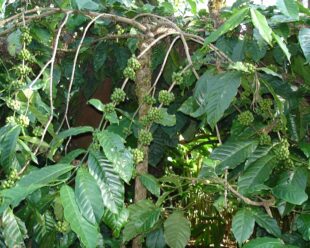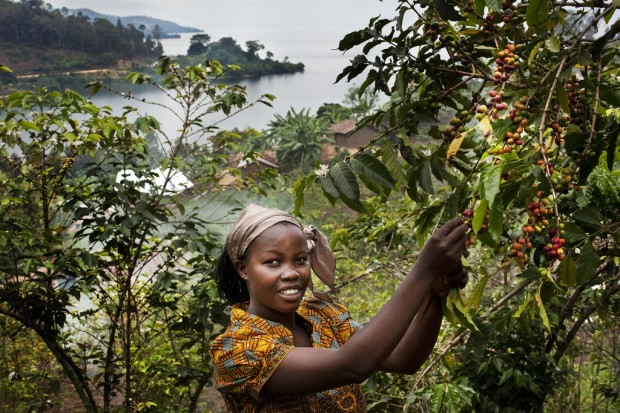A highly addictive substance with strong stimulant properties is being grown in the conflict torn hills of eastern Democratic Republic of Congo (DRC). Between 50 and 80% of the harvest is then smuggled by boat and by road across the borders into Uganda and Rwanda. One estimate puts the number of deaths by drowning whilst smuggling it across Lake Kivu to Rwanda in small boats at 1,000 a year (20 deaths a week). From Uganda and Rwanda it enters into the international market, and is exported around the world, where some of it ends up in the shops, cafes and homes of the UK. This commodity, coffee, sometimes known as ‘black gold’, will be the focus of a UK government Department for International Development (DFID) intervention to boost production and regulate the market.

In the late eighties the DRC was exporting 80,000 metric tons of coffee a year - roughly equivalent to 4 billion double espressos. In 2013 this had fallen to less than 10,000 metric tons. Since the 1980s global coffee consumption has increased by an average of 1.2% annually (International Coffee Foundation). If coffee exports from the DRC had kept up with the increase in global demand the DRC would now be exporting over 106,000 metric tons a year - 10 times what is currently exported. So what went wrong? And how can DFID help to put things right?
A complex blend of problems
One reason that coffee exports have fallen is because coffee production has fallen. This isn’t because there isn’t enough fertile land: DRC has over 80m hectares of suitable arable land, 90% of which is still unused. The sector’s decline was precipitated by a variety of factors: decades of conflict; the outbreak of a virus deadly to Robusta coffee plants; former President Mobutu’s policy of Zairianisation (expropriation of foreign-owned assets); and the collapse in world coffee prices in 1996.
But a lot of these problems have passed. So why hasn’t the sector bounced back? Part of the answer lies in what economists call ‘hysteresis’: the damage caused by an economic downturn prevents regrowth once the downturn abates. People, capital, and companies left the Congolese coffee sector during the downturn taking with them knowledge, equipment, and inputs. As a result, coffee yields in DRC are currently 4-8 times lower than global averages. Sophisticated fertilisers are either unavailable or too expensive for most growers. Seeds and seedlings are often poor quality - farmers are only able to access 15% of the quality seedlings that they need. It’s difficult for farmers to access financial services so that they can invest in their crop. And lack of access to up to date machinery and electricity makes it difficult to process the coffee in the DRC.
Another part of the problem lies in Congo’s predatory business environment. Ranked 154/175 on Transparency International’s Corruption Perceptions Index, DRC is one of the most difficult places in the world to do business. And, according to the World Bank, cumulative official taxes in DRC amount to 340% of profits. No wonder Congolese coffee growers prefer to risk their lives to get the higher prices paid for smuggled coffee by illegal buyers in Uganda and Rwanda. These illegal buyers are able to pay 10-15% more than their Congolese counterparts because of lower export tax rates and lower processing costs. Around one third of Uganda’s exports of green coffee are estimated to come from the eastern provinces of the DRC (OECD Observer).
Caffeine stimulus for growth
Why is DFID trying to fix these problems and support the growth of the coffee sector in the DRC? Basically, because we think it’s a good way to reduce poverty. Over 250,000 people in eastern DRC are already employed in the coffee sector. Simple changes to the way coffee is grown could increase their income by 80-100%. Money earned from smallholder coffee sales is typically used to supplement other sources of income and make larger purchases such as paying school fees, purchasing a tin roof, or buying a bicycle.

Moreover, we estimate that for every 5,000 metric tons more coffee that is exported there will be 250 new full time jobs and 1,250 new part time jobs. Many of these jobs would probably go to women, who currently provide the majority of labour on commercial coffee plantations.
A complex blend of solutions
Because the challenges facing the Congolese coffee sector are so complex, so are the solutions. As part of our new Private Sector Development programme in the DRC, DFID and our partners are implementing an M4P (Making Markets Work for the Poor) project following a flexible approach that aims to tackle several different parts of the coffee sector.
We are ready to test out a number of ideas to boost production: working with smallholder farmers to raise awareness of the benefits of investing in improved seedlings and agricultural practices to increase yield; training fertiliser and seed dealers to increase their sales; and helping coffee producers to become more efficient. But increased production is only part of the solution. We will also be working to boost demand through: working with buyers to improve their quality assessments and encouraging them to enter into out-grower schemes; working with the banking sector to develop financial products allowing Congolese coffee exporters to compete on world markets; and supporting the creation of an advocacy group to lobby the Government for a streamlined export tax regime for coffee.
Not all of these initiatives will succeed. None will be sufficient alone. In a conflict affected setting, entry points can change in a muzzle flash. The trick will be ensuring the initiatives work in concert to affect systemic change and remaining alert to opportunities and risks as they unfold on the ground. This won’t be easy. But whilst others wage war, coffee producers in eastern DRC are risking their lives to make a living. Strengthening the sector so they don’t have to is worth the effort.
So, hopefully, in a few years’ time, when you are sitting in your favourite coffee shop, getting your shot of caffeine, your coffee will have been produced, legally, in the DRC. And your purchase will work back through the supply chain to support coffee farmers in an increasingly peaceful and prosperous eastern DRC.
Co-authors: Euan MacMillan, Growth and economic advisor; Mischa Foxell, Humanitarian programme manager; Rebecca Clarck, Deputy programme manager, Economic Development team, DFID DRC.
Keep in touch. Sign up for email updates from this blog, or follow Chris on Twitter.

Recent Comments